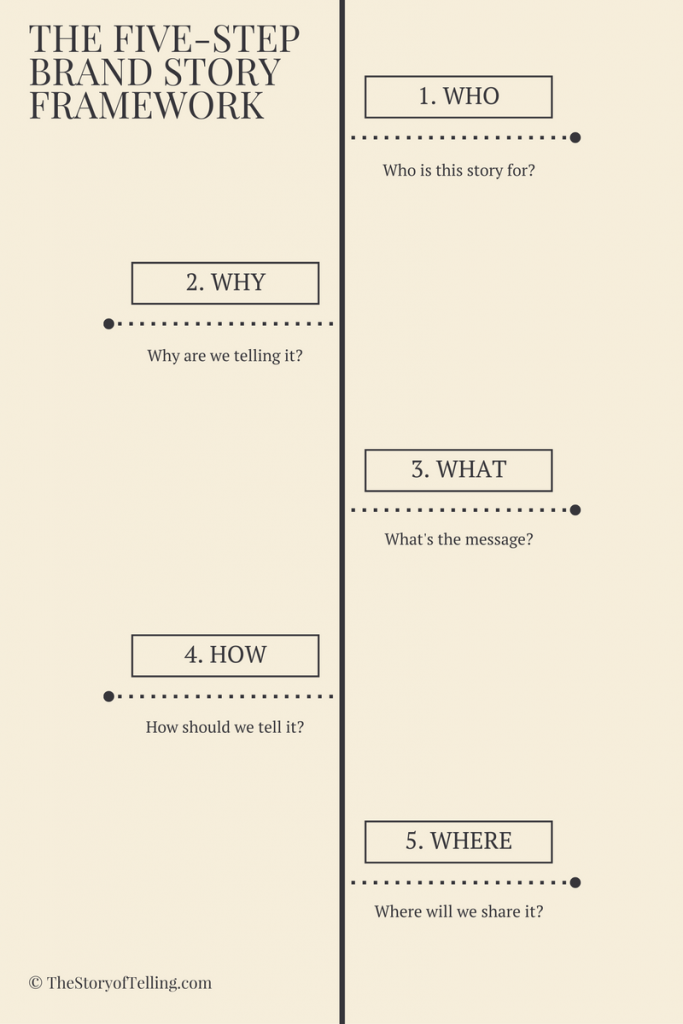Unlock the Magic in Your Story Now
Get the Free 20 questions to Ask Before Launching Your Idea workbook when you sign up for occasional updates.
Get the Free 20 questions to Ask Before Launching Your Idea workbook when you sign up for occasional updates.
How To Tell A Brand Story Customers Believe In
filed in Marketing, Storytelling
 It was a slow Wednesday morning, and the smell of freshly baked croissants wafted from the new French bakery. The store was almost empty, as were the display cabinets that should have been teeming with tempting pastries at this hour. The rock music blared. The bakery assistant who wore yesterday’s apron and a half-hearted smile, dropped the croissant she was bagging while remarking to a colleague that running out of croissants was ‘not a good look for a French bakery’. She haphazardly sealed the bag by scrunching the top with her fist. The customer paid $4.90 for the croissant. His coffee was half price because of a special promotion the bakery was running to attract more customers before 9.30am. What should have been a story about an exceptional croissant worth paying almost $5 for was broken because of the mediocre experience.
It was a slow Wednesday morning, and the smell of freshly baked croissants wafted from the new French bakery. The store was almost empty, as were the display cabinets that should have been teeming with tempting pastries at this hour. The rock music blared. The bakery assistant who wore yesterday’s apron and a half-hearted smile, dropped the croissant she was bagging while remarking to a colleague that running out of croissants was ‘not a good look for a French bakery’. She haphazardly sealed the bag by scrunching the top with her fist. The customer paid $4.90 for the croissant. His coffee was half price because of a special promotion the bakery was running to attract more customers before 9.30am. What should have been a story about an exceptional croissant worth paying almost $5 for was broken because of the mediocre experience.
Where did the bakery go wrong and how could they tell a better brand story? The biggest problem is the disconnect between their desire to pitch their product as a premium offering and supporting that story with nothing more than quality ingredients and high prices. The service design and delivery tells a different story. The empty display cabinets, discounting, poorly trained and presented staff and music that doesn’t enhance the mood, create a disconnect.
Our brand stories are not merely a way to get customers to come through the door and hand over cash—we want them to feel glad that they did. Every choice we make and everything we do must align with the story we want our brand to embody. Our actions have to support the message we want customers to believe.
The product, environment, service, and design each play a part in taking our customers on a journey we hope they’ll want to repeat. It’s our job to make sure the story is consistent from start to finish. We do that by being clear about exactly what our brand stands for and by making deliberate decisions that align with and support that vision.
Image by Emanuele Toscano.
Share this article
Success Is…
 Not surprisingly there’s been a lot of talk in the news lately about winning. It’s a subject that’s never far from our minds, especially if we’re leading or building a business. Conventional wisdom dictates that someone has to come out on top, and if we believe this is true we want it to be us and not the other guy. We don’t want to be caught short, overtaken or left behind—so we allocate resources (both material and emotional) to make sure we win. Sometimes we do this without articulating why winning is important and what it looks like. We seldom calculate what the real cost of pursuing a win above all else will be—not just on our balance sheets, but to our values, reputations, legacies, and well-being beforehand.
Not surprisingly there’s been a lot of talk in the news lately about winning. It’s a subject that’s never far from our minds, especially if we’re leading or building a business. Conventional wisdom dictates that someone has to come out on top, and if we believe this is true we want it to be us and not the other guy. We don’t want to be caught short, overtaken or left behind—so we allocate resources (both material and emotional) to make sure we win. Sometimes we do this without articulating why winning is important and what it looks like. We seldom calculate what the real cost of pursuing a win above all else will be—not just on our balance sheets, but to our values, reputations, legacies, and well-being beforehand.
If we play to win is our goal to make sure that others lose, or is it something bigger? When we forsake traditionally, narrow metrics of success—things that can easily be weighed, measured and carefully graphed, we are free to embrace a much broader definition.
As business leaders, entrepreneurs and creators, we have a choice to make. We can aim to dominate and defeat, or we can choose to build and serve.
You might remember the 70s comic strip ‘love is…’ by Kim Casali. Even as a young child, long before boyfriends and broken hearts, I adored that comic strip. It showed me that there was no one way to define love—that there was more to it than a single long-stemmed red rose version of the truth. It taught me that we each get to choose what’s important and what’s worth working towards.
The same goes for success. We get to choose how to contribute and serve, how to achieve and lead.
Winning means different things to different people. It pays to be clear about exactly what your (and your team’s) definition of success is, and to know what you’re prepared to do to achieve your goals. Because unlike loving, winning for winning’s sake is overrated.
Image by Simon.
Share this article
The Forgotten Power And Purpose Of Story
filed in Marketing, Storytelling
 As business leaders and entrepreneurs, our motivations for understanding the power of story are clear—we want to create compelling narratives so more people will hear, believe and buy into our stories. We know we can use story to inform, educate, entertain, inspire and importantly, persuade people. We leverage story to perform valuable sales and marketing functions in our businesses.
As business leaders and entrepreneurs, our motivations for understanding the power of story are clear—we want to create compelling narratives so more people will hear, believe and buy into our stories. We know we can use story to inform, educate, entertain, inspire and importantly, persuade people. We leverage story to perform valuable sales and marketing functions in our businesses.
According to Bloomberg, in the dying days of the recent U.S. Presidential election, the two campaigns spent a combined total of $44.5 million on TV advertising in battleground states attempting to persuade voters to believe their story. Overall the Clinton campaign spent $137 million more than the Trump campaign on TV advertising during the 21 weeks leading up to the election. As we know, it wasn’t enough to ensure victory.
As marketers, we understand that now more than ever our potential audience can tune out when they want to, and so we leverage every channel we have to find new ways to make them listen. The irony is that while we’ve doubled down on ‘telling’ we’ve neglected the opportunity to use story as a discovery tool—we’ve forgotten the importance of actually listening to the stories of the people we want to serve.
If we deeply understand the stories of the people we hope to convince we have a better chance of telling a story they want to hear. But more important than that—we get the opportunity to put their interests at the heart of everything we do. Imagine the difference we could create if we invested as much in trying to understand as we do on trying to be heard.
Image by Francis McKee.
Share this article
The Power Of A Value Strategy
 The city centre 7-Eleven fulfils the need of a particular customer. It’s a place for the every day, unplanned or forgotten last-minute purchases, where the worker returning home from late shift might grab headache tablets or a pint of milk. Convenience stores are not trying to deliver a premium customer experience. The business is designed to provide value by taking into account the context in which the customer will use its services. If accessibility and convenience are the pillars of the value strategy, then every business decision the company makes is filtered through that lens.
The city centre 7-Eleven fulfils the need of a particular customer. It’s a place for the every day, unplanned or forgotten last-minute purchases, where the worker returning home from late shift might grab headache tablets or a pint of milk. Convenience stores are not trying to deliver a premium customer experience. The business is designed to provide value by taking into account the context in which the customer will use its services. If accessibility and convenience are the pillars of the value strategy, then every business decision the company makes is filtered through that lens.
When a manager questions if stores should stock teddy bears or expensive perfume the answer is obvious. Everything the business does must align with the customer’s perception of the part it plays in his life.
It’s only when we are clear about how we best fulfil our customers’ needs that we can tell a story that resonates with them. In a world of the shiny, new next thing the power of consistently delivering on customers’ expectations is underrated.
Image by rpavich.
Share this article
Why You?
filed in Marketing, Storytelling
 Marketing exists because we have more choices than we need and less trust than we want.
Marketing exists because we have more choices than we need and less trust than we want.
We tend to think of marketing as the thing we do last when we’re ready to close the sale—the tactics we employ and activities we undertake to convince the customer, tell our story or describe our value. It turns out that every decision we make is marketing. Everything we do (long before people are ready to make a choice) gives them reasons to care about or choose this over that, us over them.
What did you do today that will make you worth choosing tomorrow?
Image by rotesnichts.
Share this article
The Upside Of Ignoring Your Competition
 In his memoir Bryan Cranston (the actor who plays Walter White in the cult drama series Breaking Bad), describes a mental shift he made about auditions twenty years ago. He and the other actors would smile politely at each other while they sweated it out waiting for their turn to audition. Every person in the room was attached to the outcome. They were all there competing to get something.
In his memoir Bryan Cranston (the actor who plays Walter White in the cult drama series Breaking Bad), describes a mental shift he made about auditions twenty years ago. He and the other actors would smile politely at each other while they sweated it out waiting for their turn to audition. Every person in the room was attached to the outcome. They were all there competing to get something.
Everything changed when Bryan began to focus on the process instead of the outcome. When he stopped thinking of his audition as a means to an end and became less invested in the outcome, he was free to enjoy and serve the work.
“I wasn’t going to the audition to get anything: a job or money or validation. I wasn’t going to compete with the other guys. I was going to give something.”
This new mindset meant Bryan freed himself up to give his best.
Whenever we’re trying to succeed at anything—going for a promotion, getting funding or closing the sale, we become attached to the outcome. That focus on a future we can’t control stops us fulfilling our potential in the moment.
We don’t win by trying to beat our competition. We triumph and thrive when we are motivated to do our best work, irrespective of what the competition is doing.
Image by Raphaël Labbé.
Share this article
The Five-Step Brand Story Framework
filed in Marketing, Storytelling
 Most people say the hardest part of telling their brand story is knowing where to begin. That’s because we start in the wrong place, with the wrong question—at the ‘how to’.
Most people say the hardest part of telling their brand story is knowing where to begin. That’s because we start in the wrong place, with the wrong question—at the ‘how to’.
Instead of wondering what we should say, we need to start our storytelling by asking who the story is for, and then by asking why this story will resonate with that particular audience.
Here’s the simple five-step framework to guide you through the brand storytelling process.
1. WHO —> 2. WHY —> 3. WHAT —> 4. HOW —> 5. WHERE
It’s only by understanding who for and why that we get to a better how.

Download The Five-Step Brand Story Framework to get started.
Image by Sebastian Rieger.
Share this article
Conversion Vs. Connection
filed in Marketing, Storytelling
 The sales assistant took the time to explain the candle manufacturing process, brand values and founding story to the customer who was looking for a special gift for a friend. The customer, who had been buying this brand for more than ten years left delighted, with a beautifully wrapped $42 candle. And yet the company has no idea who she is and no way of continuing the conversation with her. No way to ask for input on new products and no way to tell her about special offers. No way to understand what she might want next and no way to add more value to her life—which of course would ultimately impact their bottom line.
The sales assistant took the time to explain the candle manufacturing process, brand values and founding story to the customer who was looking for a special gift for a friend. The customer, who had been buying this brand for more than ten years left delighted, with a beautifully wrapped $42 candle. And yet the company has no idea who she is and no way of continuing the conversation with her. No way to ask for input on new products and no way to tell her about special offers. No way to understand what she might want next and no way to add more value to her life—which of course would ultimately impact their bottom line.
Our sales and marketing plans are mostly optimised to convert now. We don’t think about the next sale while we’re making this one as often as we could or should.
Converting an enquiry to a sale seems like a big win in the moment, however, it’s also an important opportunity to deepen our connection with customers. Embracing that privilege is one of the surest ways to grow a business.
What difference would it make to our businessess if we questioned how we could we deepen customer connection during every interaction?
Image by Massachusetts OTT
Share this article
Lucky To Have You
filed in Storytelling, Strategy
 The customers at Estabar are lucky to have Bec and her team creating a welcoming space where they serve the best food, gelato and coffee in Newcastle with love and care.
The customers at Estabar are lucky to have Bec and her team creating a welcoming space where they serve the best food, gelato and coffee in Newcastle with love and care.
Why are your customers lucky to have you?
You probably haven’t asked yourself this question in a while.
This is your invitation to do just that. If you’d like to share your reasons pop over to my Facebook page, (yes I finally have a home there) and add them in the comments.
It’s only when you know and embrace what you’re doing well that you can do more of it.
 When we moved house a year ago, we had the bathroom floor tiles professionally cleaned. Exactly one year on I got a message from the company about a special offer. At first glance, I thought this was a helpful reminder and smart marketing on the part of the cleaning company who had anticipated my needs. But my opinion changed when I realised the special offer was for carpet cleaning. We don’t have any carpets in our home.
When we moved house a year ago, we had the bathroom floor tiles professionally cleaned. Exactly one year on I got a message from the company about a special offer. At first glance, I thought this was a helpful reminder and smart marketing on the part of the cleaning company who had anticipated my needs. But my opinion changed when I realised the special offer was for carpet cleaning. We don’t have any carpets in our home.